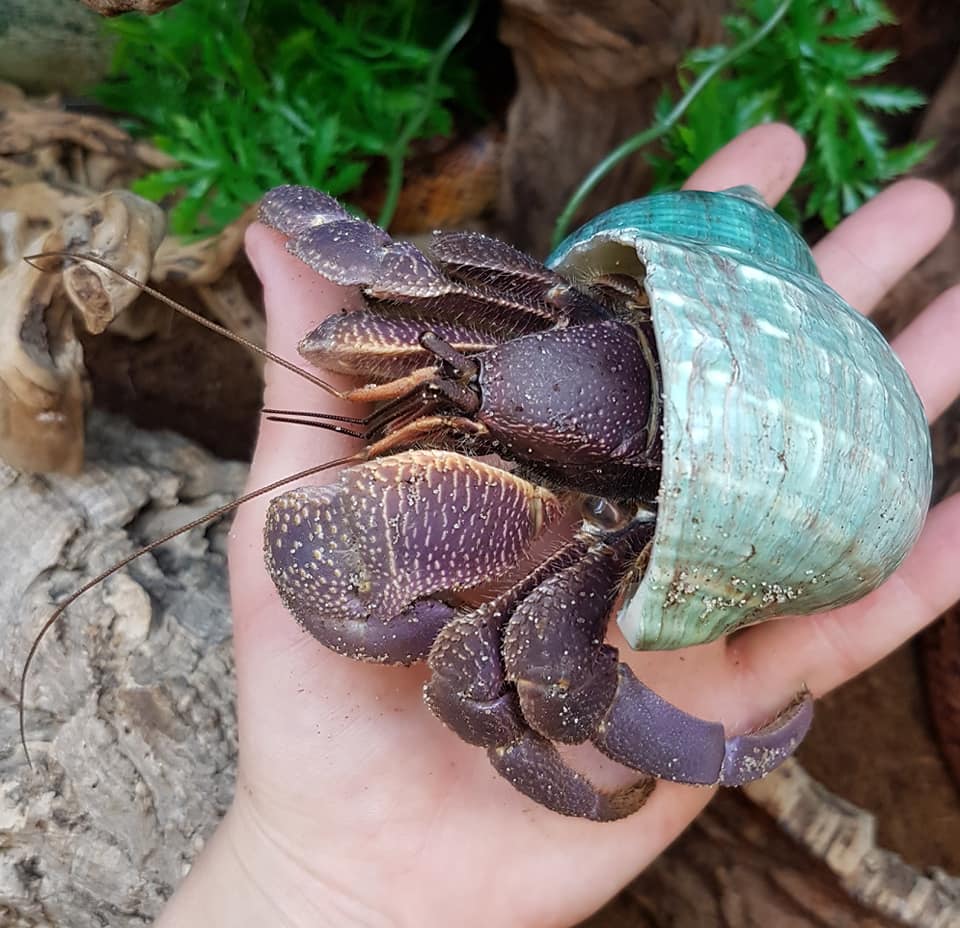I'm sure there are ready-made product you could buy, but it will depend on what's available at your local fish store. Either powdered or hopefully frozen, to at least get you started until the brine shrimp hatch.
Is this what I think it is?!?! Edit: Yep, babies!
-
wodesorel
- Tech Support

- Posts: 10587
- Joined: Thu Oct 01, 2009 8:49 am
- Location: Leetonia, Ohio
- Contact:
I'm guessing that brine shrimp are the easiest to produce, and pack a nutrient punch, and will stay alive in sea water. Brine shrimp are in the middle of the fry food sizes, with rotifers (zooplankton) and infusoria being the smallest, then brine shrimp, then crushed fish flake. Live food will also help then grow quicker, and will probably trigger their appetites as it more closely resembles what they would get in nature. Egg yolk can be used with baby fish, but they won't grow as quickly as with cultured food.
I'm sure there are ready-made product you could buy, but it will depend on what's available at your local fish store. Either powdered or hopefully frozen, to at least get you started until the brine shrimp hatch.
I'm sure there are ready-made product you could buy, but it will depend on what's available at your local fish store. Either powdered or hopefully frozen, to at least get you started until the brine shrimp hatch.
Want to see all my crazy pets? @waywardwaifs on Instagram
-
crabbyhappy
- Posts: 25
- Joined: Sun May 01, 2011 5:01 pm
- Location: New Mexico
- Contact:
I went to the pet store yesterday again, but they didn't have any Artemia, it was sold out.wodesorel wrote:I'm guessing that brine shrimp are the easiest to produce, and pack a nutrient punch, and will stay alive in sea water. Brine shrimp are in the middle of the fry food sizes, with rotifers (zooplankton) and infusoria being the smallest, then brine shrimp, then crushed fish flake. Live food will also help then grow quicker, and will probably trigger their appetites as it more closely resembles what they would get in nature. Egg yolk can be used with baby fish, but they won't grow as quickly as with cultured food.
I'm sure there are ready-made product you could buy, but it will depend on what's available at your local fish store. Either powdered or hopefully frozen, to at least get you started until the brine shrimp hatch.
I really hope at least some of them do survive!crabbyhappy wrote:Wow this is so cool! It would be so neat for you if they made it! That picture of the tiny is so cute! It sure is super teeny tiny! Good luck!
 ).
).By the way, I still haven't heard from the people on THCP.
For all who is interested, the babies are all still alive! Not a single one has died in the past two days!
C. brevimanus
C. rugosus
C. clypeatus
C. cavipes
C. violascens
C. rugosus
C. clypeatus
C. cavipes
C. violascens
-
CrabbyIrene
- Posts: 414
- Joined: Thu Jul 15, 2010 8:16 am
- Location: North Wales, PA
For all who is interested, the babies are all still alive! Not a single one has died in the past two days! And they recently became four days old.
Absolutely AMAZING!!!! Congrats & keep up the good work! Have you gotten any sleep? LOL, I don't think I would be able to...
7 PP's, 5 crazy E's!
Crabby since 2007
Crabby since 2007
CrabbyIrene wrote:
Absolutely AMAZING!!!! Congrats & keep up the good work! Have you gotten any sleep? LOL, I don't think I would be able to...
Thanks!
C. brevimanus
C. rugosus
C. clypeatus
C. cavipes
C. violascens
C. rugosus
C. clypeatus
C. cavipes
C. violascens
-
wolfnipplechips
- Posts: 1038
- Joined: Tue Jul 07, 2009 3:46 pm
- Location: Auke Bay, Alaska
- Contact:
CONGRATS!!! 
 If they make it, I have teeny tiny shells I can give you.
If they make it, I have teeny tiny shells I can give you.  It's a pretty big if, though. I realize that. But four days!! Wow!
It's a pretty big if, though. I realize that. But four days!! Wow! 
Crabby since May 2009
Hermit Crab Food Store: http://alaskahermit.com/
Pets: crabs, cats, lizards, flesh eating beetles, isopods, betta fish
Hermit Crab Food Store: http://alaskahermit.com/
Pets: crabs, cats, lizards, flesh eating beetles, isopods, betta fish
I change their water about every 3-4 hour, except when I'm asleep of course. But since I got the babies, I haven't had much sleep.Crab Addict wrote:how often do you change the water?
What do you feed them?
This is so interesting!!
Right now I feed them with phytoplankton, but I try to find Artemia somewhere. ^^
Thanks!!wolfnipplechips wrote:CONGRATS!!!
If they make it, I have teeny tiny shells I can give you.
It's a pretty big if, though. I realize that. But four days!! Wow!
Sadly two of them have died this evening.
The others seem fine though, swimming backwards and "jumping" around in the water.
Tammy and Kirk has answered!
C. brevimanus
C. rugosus
C. clypeatus
C. cavipes
C. violascens
C. rugosus
C. clypeatus
C. cavipes
C. violascens
Mine almost always went at it on the edge of a water dish, like in your pictures. Exhibitionists, I guess.SojMad wrote:Is it possible that hermit crabs mate underground?
I had two different "couples" a few years ago and coincidentally, both involved C. rugosus, although one had a C. clypeatus mate. :roll:
As I recall, both females laid copious amounts of eggs, but one of them left them in random spots away from the water.
"Nothing divides one so much as thought." - R. H. Blyth
"Sometimes the picture just ain't what it seems. You get what you want, but it's not what you need..."
"Sometimes the picture just ain't what it seems. You get what you want, but it's not what you need..."
Interesting! Maybe C. rugosus has easier to mate in captivity than other species.megs wrote: Mine almost always went at it on the edge of a water dish, like in your pictures. Exhibitionists, I guess.
I had two different "couples" a few years ago and coincidentally, both involved C. rugosus, although one had a C. clypeatus mate. :roll:
As I recall, both females laid copious amounts of eggs, but one of them left them in random spots away from the water.
How long were you able to keep the babies alive?
And the usual update of course
 ; All of the babies are still alive (except for the two who had died last time I wrote).
; All of the babies are still alive (except for the two who had died last time I wrote). C. brevimanus
C. rugosus
C. clypeatus
C. cavipes
C. violascens
C. rugosus
C. clypeatus
C. cavipes
C. violascens
-
wodesorel
- Tech Support

- Posts: 10587
- Joined: Thu Oct 01, 2009 8:49 am
- Location: Leetonia, Ohio
- Contact:
No one knows for sure since no one has gone out and DNA tested suspicious looking hermit crabs where the ranges overlap. Going by visual ID alone leads us to believe it's a possibility with South Pacific species, but only the DNA can say for sure since hermits may have natural differences within the species. If we could find a way to breed them in captivity on demand then we'd be able to find out that way also, but that's much harder than the testing.SojMad wrote:But can different species really mate with each other and produce fertile eggs?
I have to admit, I'm madly waiting for your updates every day. This is so exciting!
Want to see all my crazy pets? @waywardwaifs on Instagram
That is really interesting! But is it possible to DNA test hermit crabs without hurting them? How is the testing done?wodesorel wrote: No one knows for sure since no one has gone out and DNA tested suspicious looking hermit crabs where the ranges overlap. Going by visual ID alone leads us to believe it's a possibility with South Pacific species, but only the DNA can say for sure since hermits may have natural differences within the species. If we could find a way to breed them in captivity on demand then we'd be able to find out that way also, but that's much harder than the testing.
I have to admit, I'm madly waiting for your updates every day. This is so exciting!
Hihi, I'm glad to hear the updates are appreciated.
I took some pictures of them a few minutes ago, and also a video - not that they have grown anything, but still..
Video: http://www.youtube.com/watch?v=laKTTuX190o
Here's two of the babies.


Here's the babies in one of the jars:

C. brevimanus
C. rugosus
C. clypeatus
C. cavipes
C. violascens
C. rugosus
C. clypeatus
C. cavipes
C. violascens
-
tigermoon89
- Posts: 250
- Joined: Thu Sep 24, 2009 11:04 am
- Location: Illinois
Congrats! I enjoy reading your updates, your doing a wonderful job! 
Crystal
"There is no right way to do the wrong thing." - KingFisher
My organic hermit crab food store, Crabby Teas is now up and running! Please feel free to check out the shop. Mention the HCA and I will include a free gift! http://www.etsy.com/shop/CrabbyTeas?ref=pr_shop
"There is no right way to do the wrong thing." - KingFisher
My organic hermit crab food store, Crabby Teas is now up and running! Please feel free to check out the shop. Mention the HCA and I will include a free gift! http://www.etsy.com/shop/CrabbyTeas?ref=pr_shop
I don't know if the mixed species couple's eggs were fertile or not, they were the ones that left the eggs all over the tank & not in the water. I didn't even know what they were at first until I started cleaning them up the first night. I used to have pictures of the eggs & of them canoodling, but that was several computers & a few moves ago so who knows what happened to the files.
The other pair did have some hatch, but they died like the first day or so. I was gone & never saw them alive.
The other pair did have some hatch, but they died like the first day or so. I was gone & never saw them alive.
"Nothing divides one so much as thought." - R. H. Blyth
"Sometimes the picture just ain't what it seems. You get what you want, but it's not what you need..."
"Sometimes the picture just ain't what it seems. You get what you want, but it's not what you need..."
Thanks!tigermoon89 wrote:Congrats! I enjoy reading your updates, your doing a wonderful job!

megs wrote:I don't know if the mixed species couple's eggs were fertile or not, they were the ones that left the eggs all over the tank & not in the water. I didn't even know what they were at first until I started cleaning them up the first night. I used to have pictures of the eggs & of them canoodling, but that was several computers & a few moves ago so who knows what happened to the files.
The other pair did have some hatch, but they died like the first day or so. I was gone & never saw them alive.
Too bad you don't have the pictures, I would have loved to see them!
I'm sorry to hear you never had a chance to see the babies, they are so cute.
C. brevimanus
C. rugosus
C. clypeatus
C. cavipes
C. violascens
C. rugosus
C. clypeatus
C. cavipes
C. violascens



